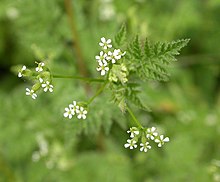
Chervil, sometimes called French parsley or garden chervil, is a delicate annual herb related to parsley. It was formerly called myrhis due to its volatile oil with an aroma similar to the resinous substance myrrh. It is commonly used to season mild-flavoured dishes and is a constituent of the French herb mixture fines herbes.
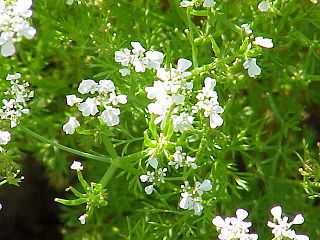
Anthriscus (chervils) is a common plant genus of the family Apiaceae, growing in Europe and temperate parts of Asia. It comprises 15 species. The genus grows in meadows and verges on slightly wet porous soils. One species, Anthriscus cerefolium is cultivated and used in the kitchen to flavor foods.

Myrrhis odorata, with common names cicely, sweet cicely, myrrh, garden myrrh, and sweet chervil, is a herbaceous perennial plant belonging to the celery family Apiaceae. It is the only species in the genus Myrrhis.
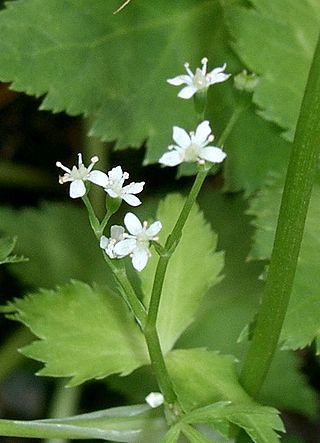
Cryptotaenia japonica, also called East Asian wildparsley, Japanese cryptotaenia, Japanese honewort, white chervilmitsuba, Japanese wild parsley, stone parsley, honeywort, san ip, trefoil, and san ye qin is a plant species native to Japan, Korea, and China. The plant is edible and is commonly used as a garnish and root vegetable in Japan, and other Asian countries.
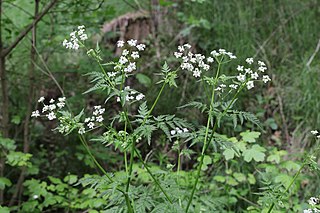
Anthriscus sylvestris, known as cow parsley, wild chervil, wild beaked parsley, Queen Anne's lace or keck, is a herbaceous biennial or short-lived perennial plant in the family Apiaceae (Umbelliferae), genus Anthriscus. It is also sometimes called mother-die, a name that is also applied to the common hawthorn. It is native to Europe, western Asia and northwestern Africa. It is related to other diverse members of Apiaceae, such as parsley, carrot, hemlock and hogweed. It is often confused with Daucus carota, another member of the Apiaceae also known as "Queen Anne's lace" or "wild carrot".

Amaranthus albus is an annual species of flowering plant. It is native to the tropical Americas but a widespread introduced species in other places, including Europe, Africa and Australia.

Scandix pecten-veneris is a species of edible plant belonging to the family Apiaceae. It is native to Eurasia, but is known to occur elsewhere. It is named for its long fruit, which has a thickened body up to 1.5 centimeters long and a beak which can measure up to 7 centimeters long and is lined with comblike bristles.

Comarum palustre, known by the common names purple marshlocks, swamp cinquefoil and marsh cinquefoil, is a common waterside shrub. It has a circumboreal distribution, occurring throughout North America, Europe, and Asia, particularly the northern regions. It is most commonly found on lake shores, marshy riversides and stream margins, often partly submerged with foliage floating. It is a parent of some Fragaria–Comarum hybrids, ornamental plants produced by crossing with strawberries.
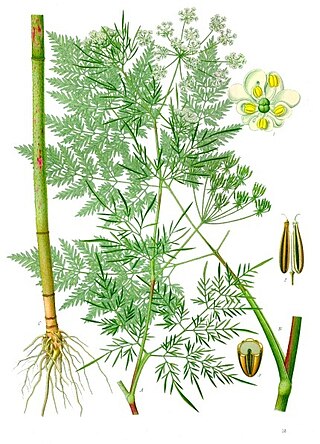
Chaerophyllum bulbosum is a species of flowering plant from the carrot family and known by several common names, including turnip-rooted chervil, tuberous-rooted chervil, bulbous chervil, and parsnip chervil. It is native to Europe and Western Asia. It was a popular vegetable in the 19th century.

Allium cratericola is a species of wild onion known by the common name Cascade onion. It is endemic to California, where is an uncommon member of the flora in several of the state's mountain ranges, including the northern and southern California Coast Ranges, the western Transverse Ranges, Klamath Mountains, and the Sierra Nevada foothills. Its range covers much of the state, from Riverside County to Siskiyou County.

Calamagrostis canadensis is a species of grass, having three or more varieties, in the family Poaceae. It is known variously by the common names of bluejoint, bluejoint reedgrass, marsh reedgrass, Canadian reedgrass, meadow pinegrass, and marsh pinegrass.

Chloris virgata is a species of grass known by the common names feather fingergrassfeathery Rhodes-grass and feather windmill grass.

Ludwigia palustris is a species of flowering plant in the evening primrose family known by the common names marsh seedbox, Hampshire-purslane and water purslane. This is an aquatic or semiaquatic perennial herb which grows in moist to wet to flooded areas. It is sometimes a weed. The species epithet palustris is Latin for "of the marsh" and indicates its common habitat.
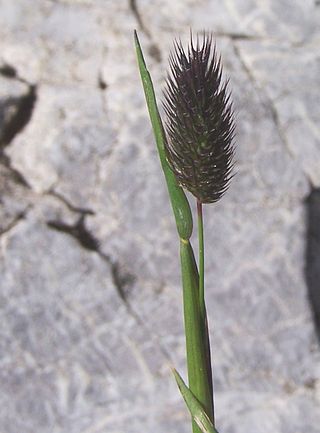
Phleum alpinum is a species of grass known by the common names alpine cat's-tail, alpine timothy and mountain timothy.

Sisymbrium orientale is a species of flowering plant in the family Brassicaceae known by the common names Indian hedgemustard and eastern rocket. It is native to Europe, Asia, and North Africa, and it can be found throughout much of the temperate world as an introduced species and in some areas a common roadside weed. It is an annual herb producing a hairy, branching stem up to about 30 centimeters tall. The basal leaves are divided into deep lobes or toothed leaflets. Leaves higher on the stem have lance-shaped blades with small separate lobes near the base. The top of the stem is occupied by a raceme of flowers with light yellow petals each measuring up to a centimeter long. The fruit is a silique which can be up to 10 centimeters long.

Sporobolus cryptandrus is a species of grass known as sand dropseed. It is native to North America, where it is widespread in southern Canada, most of the United States, and northern Mexico.

Torilis arvensis is a species of flowering plant in the family Apiaceae known by the common names spreading hedgeparsley, tall sock-destroyer and common hedge parsley. It is native to parts of Europe and it is known elsewhere, such as North America, as an introduced species and a common weed. It grows in many types of habitat, especially disturbed areas. It is an annual herb producing a slender, branching, rough-haired stem up to a meter in maximum height. The alternately arranged leaves are each divided into several pairs of lance-shaped leaflets up to 6 centimeters long each. The leaflet is divided or deeply cut into segments or teeth. The inflorescence is a wide open compound umbel of flower clusters on long, slender rays. Each flower has five petals which are unequal in size and are white with a pinkish or reddish tinge. Each greenish or pinkish fruit is 3 to 5 millimeters long and is coated in straight or curving prickles.
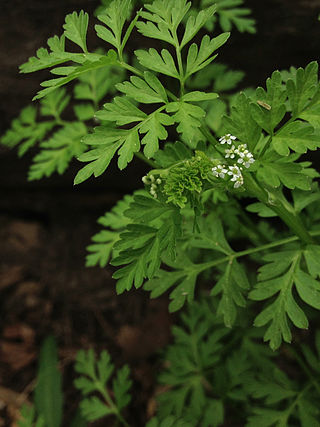
Chaerophyllum procumbens, known by the common names spreading chervil and wild chervil, is an annual forb native to the eastern United States and Canada, which produces small white flowers in spring.
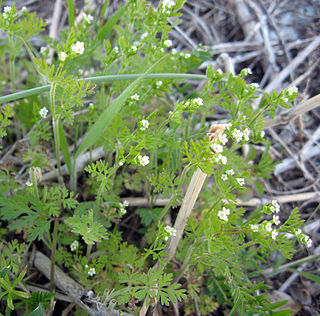
Chaerophyllum tainturieri, known by the common names hairyfruit chervil and southern chervil, is an annual forb native to the south-eastern United States, with disjunct populations in Arizona and New Mexico. It is a common plant, found in glades, fields, and disturbed areas. It produces small white umbels of flowers in the spring.

Hedypnois rhagadioloides, the Cretanweed or scaly hawkbit, is a species of plant in the tribe Cichorieae within the family Asteraceae. It is native to the Mediterranean Region and neighboring areas from Canary Islands to Iran, and naturalized in Australia and in parts of the Americas.
